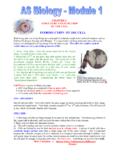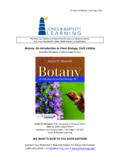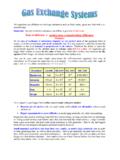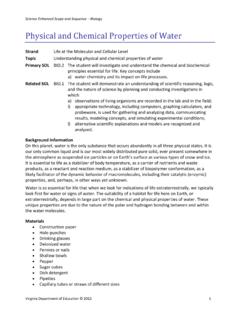Transcription of AS/A Level GCE - OCR
1 OCR 2013 QAN 500/2269/6 QAN 500/2236/2 AS/A Level GCE GCE biology OCR Advanced Subsidiary GCE in biology H021 OCR Advanced GCE in biology H421 version 4 September 2013 specification Contents 2 OCR 2013 GCE biology v4 1 About these Qualifications 4 The Three-Unit AS GCE 4 The Six-Unit Advanced GCE 4 Qualification Titles and levels 5 Aims 5 Prior Learning/Attainment 5 2 Summary of Content 6 AS Units 6 A2 Units 7 3 Unit Content 8 AS Unit F211: Cells, Exchange and Transport 8 AS Unit F212: Molecules, Biodiversity, Food and Health 16 AS Unit F213: Practical Skills in biology 1 25 A2 Unit F214: Communication, Homeostasis and Energy 27 A2 Unit F215: Control, Genomes and Environment 36 A2 Unit F216.
2 Practical Skills in biology 2 46 4 Schemes of Assessment 48 AS GCE Scheme of Assessment 48 Advanced GCE Scheme of Assessment 49 Unit Order 50 Unit Options (at AS/A2) 50 Synoptic Assessment (A Level GCE) 50 Assessment Availability 51 Assessment Objectives 51 Quality of Written Communication 52 5 Technical Information 53 Making Unit Entries 53 Making Qualification Entries 53 Grading 54 Result Enquiries and Appeals 55 Shelf-life of Units 55 Unit and Qualification Re-sits 55 Guided Learning Hours 55 Code of Practice/Subject Criteria/Common Criteria Requirements 55 Arrangements for Candidates with Particular Requirements 56 Prohibited Qualifications and Classification Code 56 Coursework Administration/Regulations 56 OCR 2013 3 GCE biology v4 6 Other Specification Issues 58 Overlap with other Qualifications 58 Progression from these Qualifications 58 Key Skills Mapping 59
3 Spiritual, Moral, Ethical, Social, Legislative, Economic and Cultural Issues 59 Sustainable Development, Health and Safety Considerations and European Developments 60 Avoidance of Bias 60 Language 60 Disability Discrimination Act Information Relating to these Specifications 61 Appendix A: Performance Descriptions 62 Appendix B: How Science Works 67 Appendix C: GCSE Criteria for Science 68 Appendix D: Mathematical Requirements 69 Appendix E: Health and Safety 70 Appendix F: Using OCR Interchange to download Practical Skills tasks 71 Vertical black lines indicate a significant change to the previous printed version. 4 OCR 2013 GCE biology v4 1 About these Qualifications This booklet contains OCR s Advanced Subsidiary (AS) GCE and Advanced GCE specifications in biology for teaching from September 2013.
4 This specification allows teachers to adopt a flexible approach to the delivery of AS and A Level biology . The course has been designed to enable centres to deliver the designated units (F211 F216) using the framework provided or to design a customised course. There is also a choice of assessed practical tasks available to all centres. The specification is divided into biological topics, each containing different key concepts of biology . Once the key features of a biological topic have been developed, applications are considered. For assessment purposes, knowledge and understanding of key concepts are treated separately at AS; important links between different areas of biology are largely assessed synoptically at A2.
5 While the teaching of practical skills may be integrated with the theoretical topics, they are assessed separately. This allows skills to be developed in a way suited to each individual centre. The Three-Unit AS GCE The Advanced Subsidiary GCE is both a stand-alone qualification and also the first half of the corresponding Advanced GCE. The AS GCE is assessed at a standard appropriate for candidates who have completed the first year of study (both in terms of teaching time and content) of the corresponding two-year Advanced GCE course, ie between GCSE and Advanced GCE. From September 2013 the AS GCE is made up of three mandatory units, of which two are externally assessed and one is internally assessed and will include the assessment of practical skills.
6 These units form 50% of the corresponding six-unit Advanced GCE. The Six-Unit Advanced GCE From September 2013 the Advanced GCE is made up of three mandatory units at AS and three further mandatory units at A2. Two of the AS and two of the A2 units are externally assessed. The third AS unit and the third A2 unit are internally assessed and will include the assessment of practical skills. OCR 2013 5 GCE biology v4 Qualification Titles and levels These qualifications are shown on a certificate as: OCR Advanced Subsidiary GCE in biology . OCR Advanced GCE in biology . Both qualifications are Level 3 in the National Qualifications Framework (NQF). Aims The aims of these specifications are to encourage candidates to: develop their interest in and enthusiasm for biology , including developing an interest in further study and careers in biology ; appreciate how society makes decisions about scientific issues and how the sciences contribute to the success of the economy and society; develop and demonstrate a deeper appreciation of the skills, knowledge and understanding of How Science Works; develop essential knowledge and understanding of different areas of biology and how they relate to each other.
7 Prior Learning/Attainment These specifications have been developed for students who wish to continue with a study of biology at Level 3 in the National Qualifications Framework (NQF). The AS specification has been written to provide progression from GCSE Science and GCSE Additional Science, or from GCSE biology ; achievement at a minimum of grade C in these qualifications should be seen as the normal requisite for entry to AS biology . However, students who have successfully taken other Level 2 qualifications in science or applied science with appropriate biology content may also have acquired sufficient knowledge and understanding to begin the AS biology course. Other students without formal qualifications may have acquired sufficient knowledge of biology to enable progression onto the course.
8 Recommended prior learning for the AS units is shown in the introduction to each AS unit. The A2 units build upon the knowledge and understanding acquired at AS. Recommended prior learning for the A2 course is successful performance at Advanced Subsidiary biology . 6 OCR 2013 GCE biology v4 2 Summary of Content AS Units Unit F211: Cells, Exchange and Transport Module 1: Cells Cell Structure Cell Membranes Cell Division, Cell Diversity and Cellular Organisation Module 2: Exchange and Transport Exchange Surfaces and Breathing Transport in Animals Transport in Plants Unit F212: Molecules, Biodiversity, Food and Health Module 1: Biological Molecules Biological Molecules Nucleic Acids Enzymes Module 2: Food and Health Diet and Food Production Health and Disease Module 3.
9 Biodiversity and Evolution Biodiversity Classification Evolution Maintaining Biodiversity Unit F213: Practical Skills In biology 1 Practical tasks OCR 2013 7 GCE biology v4 A2 Units Unit F214: Communication, Homeostasis and Energy Module 1: Communication and Homeostasis Communication Nerves Hormones Module 2: Excretion Excretion Module 3: Photosynthesis Photosynthesis Module 4: Respiration Respiration Unit F215: Control, Genomes and Environment Module 1: Cellular Control and Variation Cellular Control Meiosis and Variation Module 2: Biotechnology and Gene Technologies Cloning in Plants and Animals Biotechnology Genomes and Gene Technologies Module 3: Ecosystems and Sustainability Ecosystems Populations and Sustainability Module 4: Responding to the Environment Plant Responses Animal Responses Animal Behaviour Unit F216 Practical Skills in biology 2 Practical tasks 8 OCR 2013 GCE biology v4 3 Unit Content Each unit is divided into a number of teaching modules.
10 Within each module, the content is divided into two columns: Context and Exemplification and Assessable Learning Outcomes. Only the statements in the right hand column will be examined; statements in the left hand column are included to provide guidance on delivery. References to HSW (How Science Works) are to Appendix B. References to the GCSE Criteria for Science are to Appendix C. AS Unit F211: Cells, Exchange and Transport Module 1: Cells Cells are the basic units of all living things. Organisms function because of communication and co-operation between specialised cells. Cell division is a fundamental process, necessary for reproduction, growth and repair. Links GCSE Criteria for Science: (i) (c), (d); (i) (a) Cell Structure Context and exemplification Assessable learning outcomes The cell is the basic unit of all living things.















